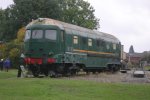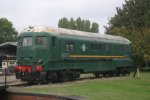John Luxton
Established Member
Currently on holiday in South Wales but looking for somewhere dryer whizzed over to GWS Didcot on the train and had a pleasant day.
This is my first visit to Didcot since 1983 and first time I have seen the pioneering gas turbine.
However, this historically important loco just looks completely unloved the body work rusting away. I bought a Didcot guide book and there is a photo of the loco in it and it looks smart and no rust. Why is it left in the open? Why no body repairs?
Could it not be refurbished and perhaps the interior developed as a display of the GWR's unfulfilled plans as it did feature in the book Next Station republished in the 1970s as the GWR's Last Look Forward?
When I last visited in 1983 the Broad Gauge display was still in development. Now that is looking uncared for. The two replicas are out of action.
Here we have key locos from the beginning and end of the GWR looking very unloved.
Surely they deserve better?
I did have a good day there today but just felt these things along with the decaying traverser loco made the place look sad.
This is my first visit to Didcot since 1983 and first time I have seen the pioneering gas turbine.
However, this historically important loco just looks completely unloved the body work rusting away. I bought a Didcot guide book and there is a photo of the loco in it and it looks smart and no rust. Why is it left in the open? Why no body repairs?
Could it not be refurbished and perhaps the interior developed as a display of the GWR's unfulfilled plans as it did feature in the book Next Station republished in the 1970s as the GWR's Last Look Forward?
When I last visited in 1983 the Broad Gauge display was still in development. Now that is looking uncared for. The two replicas are out of action.
Here we have key locos from the beginning and end of the GWR looking very unloved.
Surely they deserve better?
I did have a good day there today but just felt these things along with the decaying traverser loco made the place look sad.





